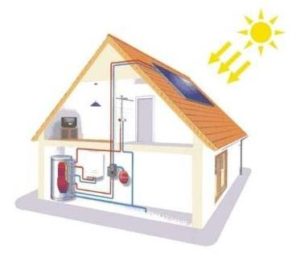Solar Water Heating in Your Home
 Sarah Heyman and her family have always been conservative when it comes to consumption. They are far from the ordinary family: Sarah rides her bike to work, and since they live near bus and MetroLink stops, they often use mass transit to get around. As a result, they have made a critical choice to live with a single car, which they use whenever necessary or convenient. “I’ve been doing this kind of thing my whole life – it’s a great way to live!” says Sarah.
Sarah Heyman and her family have always been conservative when it comes to consumption. They are far from the ordinary family: Sarah rides her bike to work, and since they live near bus and MetroLink stops, they often use mass transit to get around. As a result, they have made a critical choice to live with a single car, which they use whenever necessary or convenient. “I’ve been doing this kind of thing my whole life – it’s a great way to live!” says Sarah.
When their water heater began to fail last year, Sarah and her husband Michael wanted to explore alternatives to the traditional hot water tank. They considered a tankless option, which only heats water on demand so you don’t have to maintain a body of heated water that you may or may not need. They also looked at heating their water with solar energy, because these systems typically reduce the energy needed to heat water by 50 to 80 percent. While it’s often difficult to accurately determine how much money is spent heating water, in the average home typically 20% of the total energy consumed is used to heat water.
Sarah began exploring the potential for solar water heating by calling The Energy Savings Store. She confirmed that the shade-free southern exposure on her roof would be adequate to install a system, and began to put money away to pay for the system, which typically ranges from $6,000-$10,000. While she was sold on solar water heating, she also knew that their roof was due to be replaced and wanted to do first things first. They invested in a new high-reflectivity roof to capitalize on the federal tax incentives. The solar water heating system was also eligible for a 30% tax credit.
There are a variety of different types of solar water heating systems, which have been around for many years. The concept originated in warmer, sunnier climates that don’t freeze, and water was kept warm in storage tanks that were installed outdoors to capture direct sunlight. Modern systems typically don’t heat the water directly, but instead use a heat-transfer fluid like glycol in a closed-loop system.
There are several types of solar collectors, but the most popular in residential applications is the flat panel collector. Velux, which has long made skylights, popularized solar water heating with a collector panel that looks very much like a skylight, so it’s aesthetically pleasing.

The collector panels are installed on a south-facing roof to capture the most solar energy. The heat transfer fluid is pumped though insulated stainless-steel flextubes, which have no joints from the panels to the pumps. The pump station circulates the heated fluid through a heat-exchanger in the storage tank, which heats the water and then is returned to the panels to capture more solar energy.
The size of the system depends on the number of occupants. For 1-2 people, a single panel can be used to heat water in a 60-gallon tank. For 3-4 people, two panels are used with an 80-gallon tank, and for 5-6 people, three panels are used with a 120-gallon tank. Each system can be configured with either an electric or natural gas backup heating system to cover either heavy usage (like overnight guests) or extended periods of dark, cloudy days. The tanks are very well insulated, so the water stays warm overnight and requires very little additional energy to maintain a comfortable temperature.
The Heymans chose to go with a 60-gallon tank using a single collector for their 3-person family. They program the dishwasher to run during the day, and use other measures to conserve hot water, like using low-flow shower heads and washing most of their laundry in cold water.
While the Heymans plan to be in their home for a long time, they know that their solar water heating system will be an attractive selling feature should they ever decide to move. Renewable energy and efficiency improvements typically add $20 to the value of the home for every dollar saved annually, and the average family will save $400-$500 a year. So the energy savings coupled with the added property value makes it a smart investment.
“It’s always there when we need it,” says Sarah, “and it feels good to know that we’re using clean, renewable energy to heat our water.”
Published in the St. Louis Globe-Democrat’s “The Green Life” on July 5, 2010

0 Comments